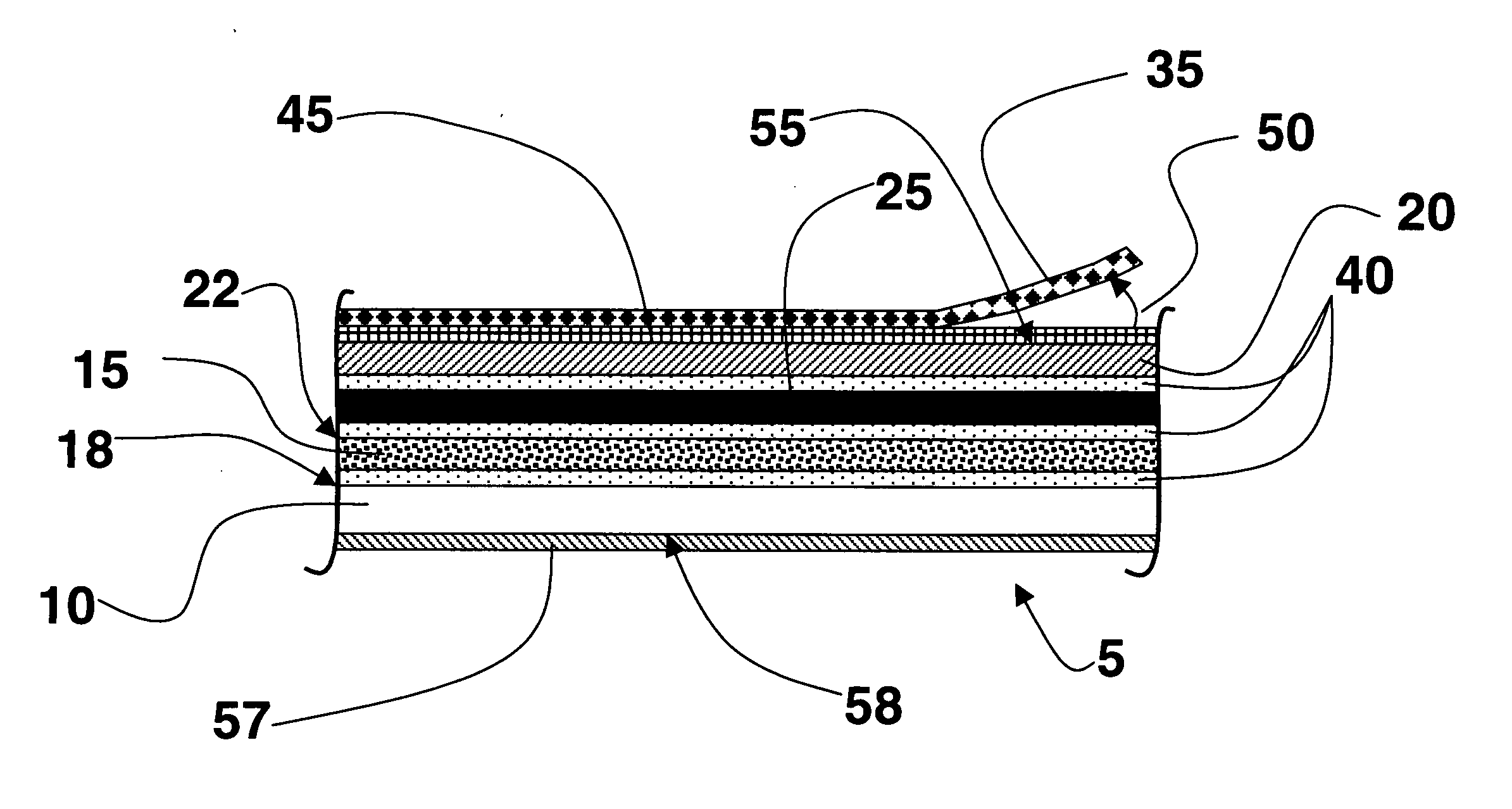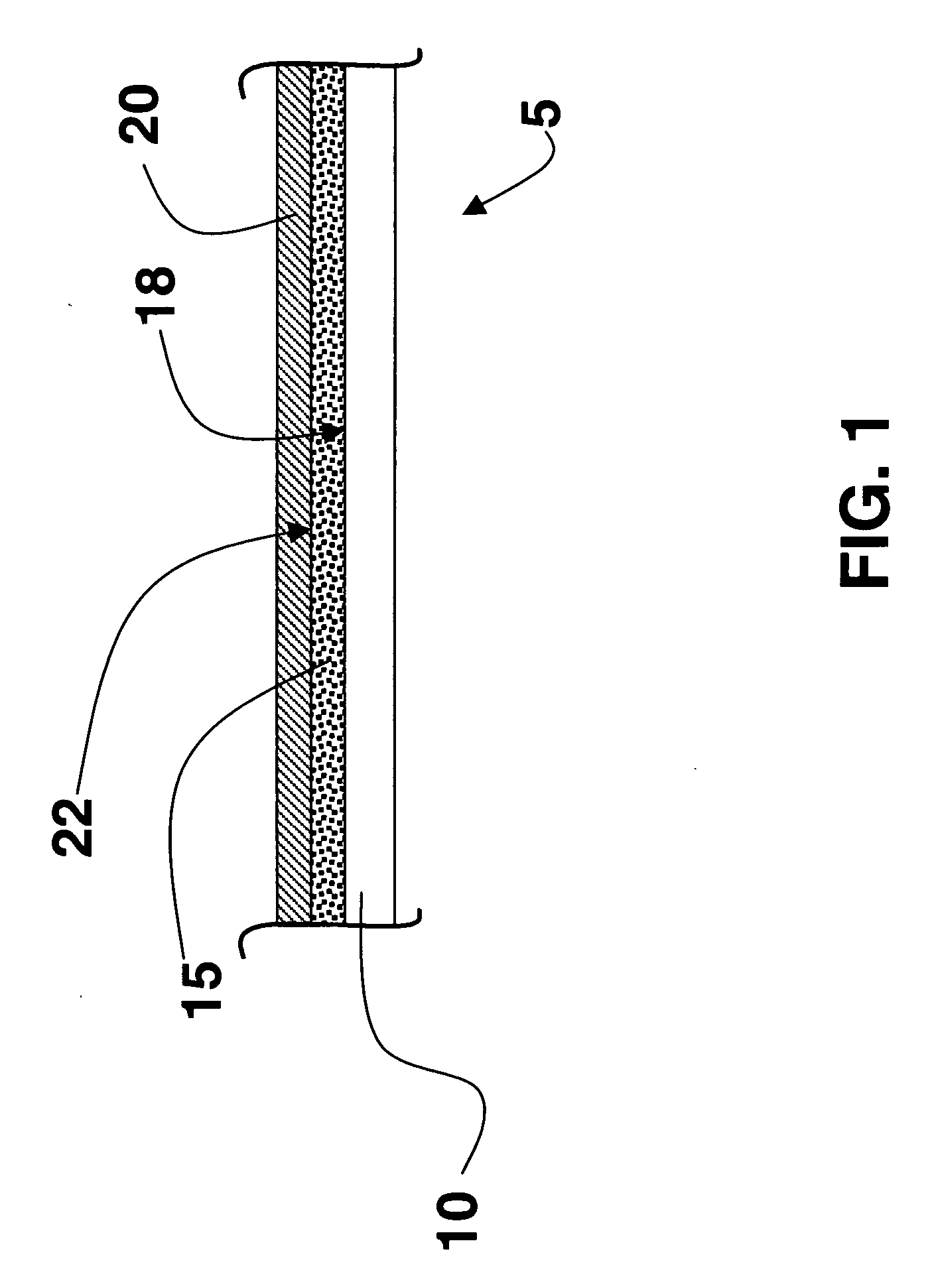Device for sensing contaminants
a technology of contaminants and sensors, applied in the field of devices, can solve the problems of rapid methods, possibly as little as 30 minutes or less, and achieve the effects of simple and easy to interpret, easy to use, and no loss of effectiveness
- Summary
- Abstract
- Description
- Claims
- Application Information
AI Technical Summary
Benefits of technology
Problems solved by technology
Method used
Image
Examples
example 1
[0210] In this example, no blocking layer was used. All steps occurred in a dark room with safe lights. Standard wet chemical development, including a fix and wash, were used. We used Kodak Polymax II RC paper. A strip of this paper was cut to about 2.5 cm×15 cm. The bottom 1 to 1.5 cm of this film was suspended in a solution consisting of D85 developer. D85 developer is a black-and-white photographic developer containing primarily the LIFCS hydroquinone in a boric acid buffer. The strip was incubated for 5 minutes at 37-40° C. This was done at 3 concentrations of hydroquinone: 0.2 M, 0.02 M, and 0.002 Molar.
[0211] The strip was rinsed for 5 seconds and then the bottom 2.5 cm of this film was developed in D76 for 1 minute. The bottom 5 cm region was fixed. The change in size of development and fixing regions allowed a clear comparison of the exposed (to the LIFCS hydroquinone) and unexposed regions of the strip. The density in the different regions was not quantified, but showed co...
example 2
[0214] This is a prophetic example. In this example, no blocking layer is used. All steps occur in a dark room with safe lights. Standard wet chemical development, including a fix and wash, are used. The substrate for the film is PET, prepared with a gel sub, and then coated with 1.6×103 mg / m2 silver as a silver chloride cubic emulsion and 3.2×103 mg / m2 gel. A sample layer of gelatin incorporating hydroquinone at 1000 mg / m2 is coated on top. A strip of this film is cut to about 2.5 cm×7.5 cm.
[0215] A 1 mm spot of anti-E. coli antibody in phosphate buffered saline (PBS) is placed on the film and allowed to dry for 1 minute. At a concentration of approximately 100 microgram / ml and a volume per spot of 20 nl, the coverage is estimated at 0.05 mg / m2 of antibody.
[0216] This 1 mm spot is exposed to E. coli in a solution at approximately 1×104 cfu / ml, and incubated at 37° C. for 10 minutes. Concurrently, on the same strip for the same 10 minutes, but in a different location, a 1 mm spot ...
example 3
[0219] This is a prophetic example. In this example, no blocking layer is used. All steps occur in a dark room with safe lights. Standard wet chemical development, including a fix and wash, are used. The substrate for the film is PET, prepared with a gel sub, and then coated with 1.6×103 mg / m2 silver as a silver chloride cubic emulsion and 3.2×103 mg / m2 gel. A sample layer of gelatin incorporating polystyrene beads (2. A strip of this film is cut to about 2.5 cm×7.5 cm. An E. coli solution of approximately 1×104 cfU / ml is spotted on the film (0.01 ml). A PBS solution is spotted on the film (0.01 ml). The films are incubated at 37° C. for 20 minutes, and then developed for 1 minute in Kodak D76. The film strip is fixed for 30 seconds, and then washed for 30 seconds. The developed film shows a black spot at approximately the location of the exposure to E. coli, and very little black elsewhere, including the spot exposed to only PBS. The ratio of the density of the E. coli spot to the ...
PUM
| Property | Measurement | Unit |
|---|---|---|
| thicknesses | aaaaa | aaaaa |
| thickness | aaaaa | aaaaa |
| thickness | aaaaa | aaaaa |
Abstract
Description
Claims
Application Information
 Login to View More
Login to View More - R&D
- Intellectual Property
- Life Sciences
- Materials
- Tech Scout
- Unparalleled Data Quality
- Higher Quality Content
- 60% Fewer Hallucinations
Browse by: Latest US Patents, China's latest patents, Technical Efficacy Thesaurus, Application Domain, Technology Topic, Popular Technical Reports.
© 2025 PatSnap. All rights reserved.Legal|Privacy policy|Modern Slavery Act Transparency Statement|Sitemap|About US| Contact US: help@patsnap.com



